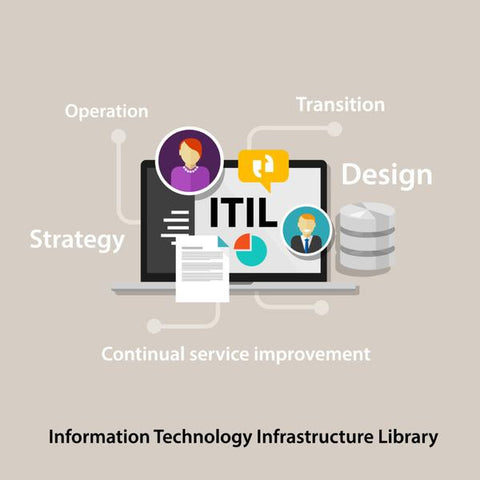What Is ITIL And Its Lifecycle?
Introduction
ITIL stands for Information Technology Infrastructure Library. It is a well-known set of guidelines used to manage intricate technology systems. It originated in the United Kingdom during the 1980s as a method of coping with increasing dependence on technology and has since transformed into a universally accepted knowledge-base that organizations use to optimize their technology infrastructure. To perform at their best, organizations must offer customers useful and competitive products and services. The ability to adapt quickly to volatile economic and technological environments is essential for sustained growth. The ITIL Service Lifecycle is a strategy that organizations can use to engage in a perpetual cycle of improvement for their services.

Over the years, ITIL has grown and evolved after being revised several times to keep up with the fast-changing landscape of technology and its impact on organizations.
Today, ITIL is in its third version, often referred to as v3. ITIL provides a method that organizations can utilize to increase the efficacy of their IT services while reducing their cost.
What Is The ITIL Service Lifecycle?
The “IT Service Lifecycle” refers to an all-encompassing framework that spans the lifetime of information technology within an organization. Primary elements of this lifecycle are:
- Service Strategy
- Service Design
- Service Transition
- Service Operation
- Continuous Service Improvement
Each of these five elements has a specific guideline, requirement, and process detailed for each stage of the lifecycle phase. This allows organizations the ability to implement ITIL in focused areas or in a comprehensive manner. The most effective implementation comes about as a result of adopting the lifecycle principles in their entirety.

ITIL Overview
1. Service Strategy
The cornerstone of the ITIL lifecycle is the service strategy. The service strategy contains the financial models, requirements, and goals for the IT systems of an organization. In this strategy, the full range of service operations is laid out, along with policies or principles for consideration. Simply put, this element describes the overall goal of the services lifecycle.
2. Service Design
In the ITIL lifecycle, service design refers to the blueprint used by an organization to create the IT infrastructure it needs to complete its service strategy. This aspect identifies the people and resources necessary for the successful execution of that strategy. It also includes changes relating to new rules and regulations.
3. Service Transition
After having determined the strategy and design phases, our organization must then focus on service transition. The goal of this is to align operations with projects. Every aspect of our service comes together to make sure it has been tested and integrated as a whole. Paying adequate attention to the details of this phase can cut down on unexpected problems later on.
4. Service Operation
The purpose of service operation is to enable comprehensive practices that allow us to sustain stable services. Our operational team handles Incident Management and takes feedback on customer satisfaction.
5. Continual Service Improvement
The final phase of the ITIL lifecycle serves to integrate and maintain the other four.
Continual service improvement means that we are always aligning our services with the needs of our business, seeking opportunities for improvement, and changing practices accordingly.

What Are The Benefits Of ITIL?
The development of ITIL occurred through a collaborative effort on the part of a large number of experts and organizations. It provides a versatile and dynamic framework that can be applied to any organization due to being conceived by a wide range of IT experts and professionals.
The ITIL approach provides a number of advantages -
1. Improved Service Quality: ITIL provides a framework for delivering high-quality services, ensuring that they meet or exceed customer expectations. This leads to increased customer satisfaction and loyalty.2. Enhanced Customer Experience: By focusing on customer needs and aligning services with business objectives, ITIL helps organizations create a positive and consistent customer experience. This can result in improved relationships with customers and stakeholders.
3. Efficient Service Delivery: ITIL emphasizes efficient and effective processes for service delivery and support. This can lead to streamlined operations, reduced downtime, and improved overall efficiency in IT services.
4. Better Risk Management: ITIL practices include risk management strategies, helping organizations identify and mitigate potential risks before they escalate. This proactive approach contributes to increased system stability and reliability.
5. Cost Savings: Through better resource utilization, streamlined processes, and proactive problem management, ITIL can contribute to cost savings. This is achieved by optimizing IT services and minimizing the impact of incidents and disruptions.
6. Clearer Communication and Collaboration: ITIL encourages clear communication and collaboration among different departments within an organization. This alignment helps break down silos, fostering a more integrated and cohesive approach to service delivery.
Conclusion
By using ITIL, we can incorporate changing elements of our customer’s needs while also increasing stability and reducing risk. These processes allow us to act in accordance with changing circumstances in short order. By aligning plans for services with plans for the business, we can decrease the likelihood of unexpected deficiencies in business performance. In short, the ITIL service lifecycle allows us to engage in a positive feedback loop. Our service strategy, design, transition, and operation are integrated into continual service improvement so that present and future challenges are met and adapted with ease.








